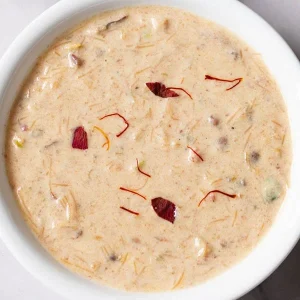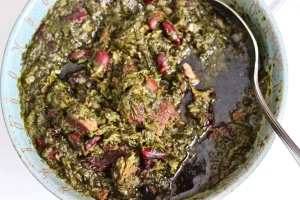The Mughal Empire, reigning over the Indian subcontinent from the 16th to the 19th century, wasn’t just a period of political power. It was also a golden age of art, architecture, and, most importantly for our taste buds, cuisine. Mughal food was a spectacular fusion of influences, blending Central Asian traditions with Indian spices and techniques. This list explores 10 delectable dishes that defined Mughal gastronomy:
- Kabuli Pulao: This fragrant rice dish, a staple at Mughal feasts, originated in Kabul, Afghanistan. Long-grained basmati rice is cooked with aromatic spices like cardamom, cloves, and saffron, then layered with succulent pieces of lamb, caramelized onions, and nuts like pistachios and almonds. The dish embodies the Mughal love for rich flavors and textures.

Kabuli Pulao -
Korma: The word “korma” literally translates to “braise” or “fry.” Mughal kormas are slow-cooked stews, usually featuring meat like lamb, chicken, or even fish, simmered in a creamy yogurt or nut-based gravy. The gravy is often flavored with fragrant spices like cardamom, cinnamon, and garam masala, resulting in a dish that is both luxurious and comforting. Popular variations include the white Rogan Josh, with its vibrant red hue from Kashmiri chilies, and the green Nargisi Kofta, featuring deep-fried dumplings filled with minced lamb and egg.

Korma -
Dum Biryani: This layered rice dish is a true Mughal masterpiece. Meat, often marinated with yogurt and spices, is layered with fragrant basmati rice, vegetables like peas and carrots, and aromatic spices like saffron and rosewater. The dish is then sealed in a pot and slow-cooked over a gentle flame, allowing the flavors to meld and permeate the rice. When finally revealed, the Dum Biryani is a feast for the eyes and the palate, with its fluffy rice, succulent meat, and a symphony of delicate spices.

Dum Biryani -
Shahi Tukda: This decadent bread pudding is a fitting finale to any Mughal feast. Deep-fried squares of bread are soaked in a fragrant syrup flavored with cardamom, saffron, and rosewater. The dish is then garnished with nuts like pistachios and silver leaf, a testament to the royal origins of Mughal cuisine.

Shahi Tukda -
Mirchi Ka Salan: This dish may surprise you. Literally translating to “chilli curry,” Mirchi ka Salan is not about fiery heat, but a delightful balance of sweet and savory. Green chilies are roasted and simmered in a yogurt-based gravy with a touch of jaggery or honey. The result is a tangy and flavorful accompaniment to richer dishes like kebabs or biryani.

Mirchi Ka Salan -
Sheer Khurma: This rich vermicelli pudding is a delightful treat, especially during festivals like Eid. Thin strands of vermicelli are cooked in a creamy milk base flavored with cardamom, saffron, and nuts like almonds and pistachios. The resulting pudding is sweetened with sugar or condensed milk, creating a textural and taste sensation that is both luxurious and comforting.

Sheer Khurma -
Yakhni Pulao: This light and flavorful rice dish is a welcome departure from the richness of other Mughal fare. Yakhni translates to “stock,” and this dish features basmati rice cooked in a flavorful chicken or lamb broth, infused with delicate spices like cardamom and bay leaves. The finished product is a simple yet elegant dish, perfect for a light meal or as a base for heavier curries.

Yakhni Pulao -
Shammi Kebab: These melt-in-your-mouth kebabs are a true Mughal delicacy. Minced meat, usually lamb or chicken, is mixed with lentils, herbs, and spices like ginger and garlic. The mixture is then shaped into small patties and shallow-fried until golden brown. The result is a flavorful and juicy kebab, perfect as an appetizer or enjoyed in a wrap with mint chutney and onions.

Shammi Kabab -
Qorma Sabzi: This vegetarian delight offers a flavorful alternative to meat-based Mughal dishes. A medley of fresh vegetables like spinach, cauliflower, and peas are simmered in a creamy yogurt or nut-based gravy, infused with aromatic spices like coriander and cumin. The dish is a perfect balance of textures and flavors, showcasing the versatility of Mughal cuisine.

Qorma Sabzi -
Falooda: This refreshing dessert is a delightful way to end a meal on a cool note. Thin vermicelli noodles are layered with crushed ice, rose syrup, and falooda seeds (sweet basil seeds soaked in water), creating a textural contrast. The dish can be further embellished with fresh fruits like mango or strawberries for added sweetness and refreshment.

Falooda
These 10 dishes represent just a glimpse into the vast and vibrant world of Mughal cuisine. This rich culinary heritage continues to inspire chefs and home cooks today, with its emphasis on fresh ingredients
